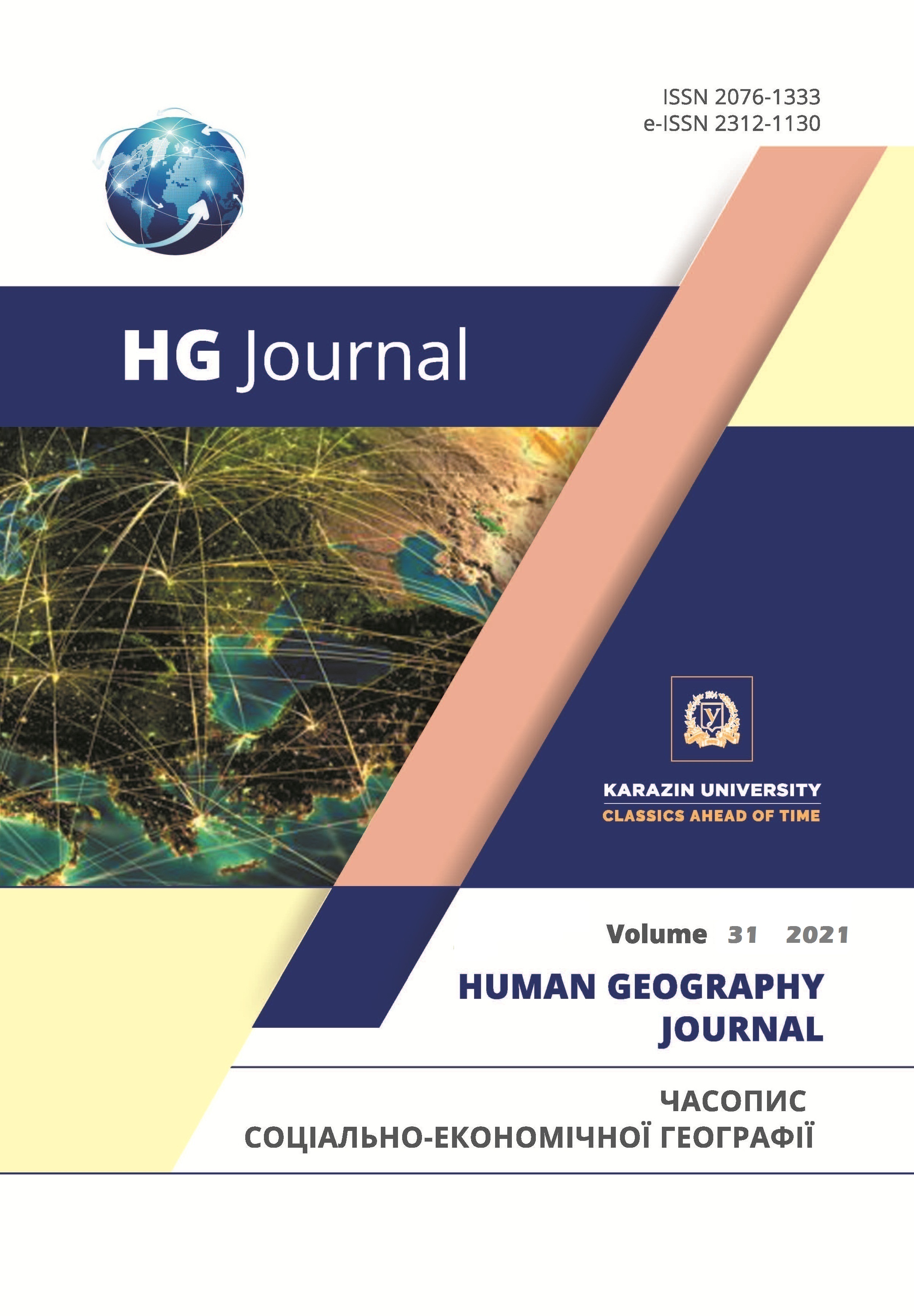Концепція туристичних потоків і географія туризму
Анотація
Здійснено критичний аналіз основних концепцій географії туризму, та встановлено, що найпопулярніші з-поміж них присвячені місцям призначення туристів, що правильно для рекреації, а для туризму – наполовину хибне через однобокість, адже ігнорується звичне середовище, звідки походить турист, де, власне, і формуються рекреаційні потреби, які лише потім задовольнятимуться в дестинаціях. Щоби уникнути цього недоліку, запропоновано розглядати туризм як форму міграції населення через туристичні потоки, які з’єднують місця походження та призначення туристів, що дозволяє побачити це явище цілісно. За теоретико-методологічний фундамент обрана парадигма поведінкової географії, яка розглядає територіальну поведінку людей через їхні життєві лінії, які в туризмі постають як туристичні поїздки. При цьому має значення масова поведінка як односпрямовані численні поїздки, що формують туристичні потоки. Розкривається діалектичний характер туристичного потоку, коли місця походження та призначення туристів єднає механічний рух людей, який заснований на протиставленні тимчасового перебування в дестинації постійному мешканню у звичному середовищі.
Як головне авторське бачення, запропонована та обґрунтована концептуальна модель формування та розподілу міжнародних туристичних потоків у географічному просторі, яка актуальна й для внутрішнього туризму. Вона побудована на висвітленні апперцепції звичного середовища через формування динамічних стереотипів, а також на основі запропонованих базових туристичних мотивів. До них віднесені: мотив міграції, комфорту, контрасту, естетики. Мотив міграції, який виштовхує туристів зі звичного середовища, узгоджується з відомою концепцію ескапізму як втечею від рутини повсякденності. Мотив контрасту, що притягує до відмінних від звичного середовища місць призначення, знаходить своє відображення в інверсійні поведінці туриста, запропонованій Грабурном. Ці мотиви отримали обґрунтування на основі динамічних стереотипів І. Павлова, що викрило ланку, якої бракувало для розуміння мотиву комфорту. На основі цих мотивів, об’єднаних в мотиваційну систему, що структурована за такими географічними складовими туристичного потоку, як звичне середовище і дестинації, на тлі таких властивостей географічного простору, як протяжність і строкатість, запропонована концептуальна модель територіальної поведінки людей у модусі туриста.
Завантаження
Посилання
Alaev, E. B. (1983). Socialno-ekonomicheskaia geografiia: poniatiino-terminologicheskii slovar [Socio-economic geog-raphy: conceptual and terminological dictionary]. M.: Mysl, 350 p. [in Russian].
Gold, J. (1990). Osnovy povedencheskoi geografii [Fundamentals of behavioral geography]. M.: Progress, 280 p. [in Russian].
Grodzinsky, M. D, & Savitskaya, O. V. (2005). Estetyka landshaftu: navch. posib. [Aesthetics of the landscape: text-book], Kyiv, VPC, 183 p. [in Ukrainian].
Husserl, E. (2009). Idei k chistoi fenomenologii i fenomenologicheskoi filosofii [Ideas for pure phenomenology and phenomenological philosophy]. М.: Academ. Project, 489 p. [in Russian].
Johnston, R. J. (1987). Geografiya i geografy: Ocherk razv. anglo-amer. sots. heohrafii posle 1945 h. [Geography and Geographers: Essay on the development of Anglo-American. soc. geography after 1945]. Ed. by E.B. Alaev, M.: Pro-gress, 368 p. [in Russian].
Korol, O. D. (2018). Mizhnarodni turystychni potoky: suspilno-heohrafichni aspekty formuvannia ta heoprostorovyi rozpodil: monohrafiia [International tourist flows: socio-geographical aspects of formation and geospatial distribution]. Chernivtsi: Chernivtsi National University, 512 p. [in Ukrainian].
Krachylo, M. P. (1992). Heohrafiia naselennia [Geography of the population]. Kyiv, NMC, 180 p. [in Ukrainian].
Krachilo, N. P. (1987). Heohrafiia turizma [Geography of tourism]. Kyiv, Vyshcha shkola, 208 p. [in Russian].
Kuzyk, S. (2010). Teoretychni problemy turyzmu: suspilno-heohrafichnyi pidkhid: monohrafiia [Theoretical problems of tourism: socio-geographical approach]. Lviv, LNU by Ivan Franko Publishing Center, 254 p. [in Ukrainian].
Lippman, W. (2004). Obshchestvennoe mnenie [Public opinion]. Moscow: Institute of Public Opinion Foundation, 384 p. [in Russian].
Lyubitseva, O. O., Malska, M. P., & Zinko, Y. V. (2010). Kontseptualni zasady heohrafii rekreatsii i turyzmu [Conceptual principles of geography of recreation and tourism]. Heohrafiia ta turyzm – Geography and tourism journal, 11, 3-13 [in Ukrainian].
Maslow, A. (2012). Motivatsiia i lichnost [Motivation and personality]. Publisher: Peter, 352 p. [in Russian].
Pavlov, I. P. (1951). Polnoe sobranie sochinenii [Full composition of writings]. 2nd ed., vol. 4, M.–L. [in Russian].
Pokolodna, M. M. (2012). Rekreatsiina heohrafiia: navch. posibnyk [Recreational geography: textbook]. Kh.: Kharkiv nat. acad. city households, 275 p. [in Ukrainian].
Preobrazhenskii, V. S., Vedenin Y. A., Zorin, I. V., & Mukhina, L. I. (1984). Territorialnaia rekreatsionnaia sistema kak ob`ekt izucheniia heohraficheskikh nauk [Territorial recreational system as an object of study of geographical sciences]. Izvestiia AN SSSR: Seriia heohraficheskaia – Proceedings of the USSR Academy of Sciences: Geographic series, No. 2 [in Russian].
Sarancha, M. A. (2009). K izotropnym modeliam turistsko-rekreatsionnykh mihratsii [On isotropic models of tourist and recreational migrations]. Vestnik udmurtskoho universiteta: Biolohiia, Nauki o zemle – Bulletin of the Udmurt University: Biology, Earth Sciences, 1, 137-141 [in Russian].
Preobrazhenskii, V. S. (1975). Teoreticheskie osnovy rekreatsionnoi geografii [Theoretical foundations of recreational geography]. Ed. by V. S. Preobrazhenskii. М.: Science, 224 p. [in Russian].
Urri, J. (2005). Vzghliad turista i globalizatsiia, Massovaia kultura: Sovremennye zapadnye issledovaniia [The view of the tourist and globalization, Mass culture: Modern Western research journal]. M.: Pragmatics of culture, pp. 136-150 [in Russian].
Ukhtomskii, A. A. (1966). Dominanta [Dominant]. M.-L.: Science [in Russian].
Heidegger, M. (2015). Bytie i vremia [Being and time], transl. by V. V. Bibihin, 5th ed, М.: Academ. Project, 460 p. [in Russian].
Boniface, B., & Cooper, C. (2009). Worldwide Destinations: The Geography of Travel and Tourism, Elsevier Ltd. Fifth edition, 644 p.
Butler, R. W. (1980). The concept of a tourist area cycle of evolution: implications for management of resources. Cana-dian Geographer, 24, 5-12.
Hagerstrand, T. (1970). What about people in regional science? Lund: Springer, Verlag.
Leiper, N. (1979). The framework of tourism: towards a definition of tourism, tourist, and the tourist Industry. Annals of Tourism Research, 6(4), 390-407.
Miossec, Jean-Marie (1977). Un modèle de l'espace touristique. In: Espace géographique, tome 6, No 1, pp. 41-48.
Tuan, Yi-Fu (2001). Space and Place: The Perspective of Experience, University of Minnesota Press, 235 p.
Williams, S. (2009). Tourism geography: a new synthesis, New York, Routledge, 310 p.
Авторське право (c) 2021 Олександр Король

Цю роботу ліцензовано за Міжнародня ліцензія Creative Commons Attribution 4.0.




